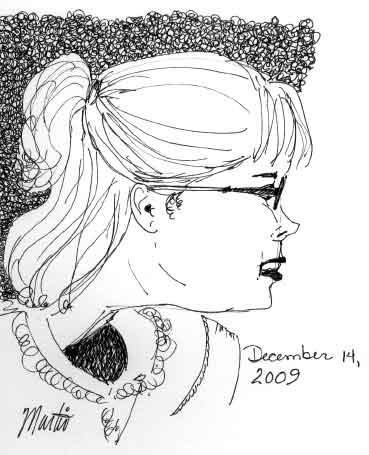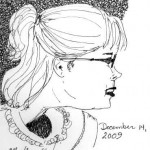I received an email from a fan the other day. She was a young artist, 9 years old, according to her message. She asked my advice on how to become a better artist. I’ve thought about it for several days and decided that more than one fledgling artist or illustrator could benefit from my answer to her. So instead of just sending her a reply, I am blogging my advice to her here.
The 5 secrets to be a better artist and improve your skills:
1. Draw every day.
This is number one because in my mind it is the most important. Drawing is a skill. In order to improve the skill, one needs to practice it every day. Think of musicians and athletes. They practice for hours every day. Even after they have achieved a level of success, they continue to practice. Practice is a life long commitment.
Drawing every day gives the artist time to explore new ideas, work on challenges in perspective, proportion and perception. Drawing everyday strengthens the eye-hand-brain coordination and the pathway from the brain to the hand. Contrary to popular belief, the artist’s talent lies in his or her head. The muscles between the head and the hand need to be stretched continuously in order for the ideas in the artist’s brain to appear on a blank piece of paper.
Drawing can be likened to running. A marathon runner trains a long time before running an actual marathon. It is a rare runner indeed who can decide one morning to run a marathon that afternoon and actually accomplish such a goal. Short distances are covered over a long period of time until the body and muscles are ready to pursue the miles in a marathon. Daily sketching is akin to the training sessions of the runner.
2. Draw from life
Even fantasy artists have to study life to see how things work. Physics work for a reason. A muscle is attached to a bone and joints work in certain ways. The only way an artist can learn these things is to study actual models in action. By studying people, animals and stationary objects in real life, an artist can add to his or her visual data banks. The way light acts in different settings, the way people move and interact, the way trees grow, all of this is necessary knowledge for an artist’s works to be believable. Looking at subjects in 3 dimensions is a huge bonus for all artists working in any kind of representational manner. Yes, some artists only use photographs for their reference, but when beginning a career in the arts, nothing is as good as daily life observation and recording. Photographs just can’t supply all the relevant information since they take the three-dimensional and make it two-dimensional. This is especially true if an artist is attempting to recreate any kind of foreshortening.
3. Study the masters
The work of master artists you admire is the best teacher you can have. My personal favorites are Michelangelo, D’Vinci, Durer, Mucha, Escher, and Rembrandt. I also have some modern-day artist web sites book marked and visit their sites over and over to study their art. When I am struggling with a new subject I have never attempted before, visiting the web sites of other artists to see how they handle a similar image often jump-starts my creative process and I can get over the hump.
In many art programs, the students are given assignments to study and recreate great works of art. This a wonderful lesson in learning technique and style. Of course, it is meant as a learning tool in developing one’s own unique style and vision. After all, the masters of the past often started out as some one’s apprentice before striking out on their own. Many masterpieces attributed to a Renaissance master are also works contributed to by his apprentices. Modern day comic book artists work in a similar manner. They do the original pencils and then hand off the sketches to inkers and colorists. Walt Disney animations had huge staffs of artists working behind the scenes to create all the cells needed to animate the feature-length films.
4. Attend classes by other artists
In my early career, I took many art classes with visiting professional artists. I belonged to many different groups to get access to the workshops provided by artists from all over the country. In fact, I still take art classes every once in a while now. A different artist works in a different manner, with a different palette and a different set of tools. It is a rare class where there isn’t something I can gain from the teaching artist, even if I have been creating art as long as they have.
5. Find your own unique style and perfect it
Whether you are a commercial artist or a fine artists, if you wish to be a professional, people must be able to recognize your work as yours. Think of the list of masters I mentioned above. Even if you are not familiar with all the names, the names you recognized bring up a style of art specific to that particular artist.
This doesn’t mean you can’t change and grow as an artist. Even the masters have different periods of art in their histories. An artistic career can span decades. The work created in the beginning of a career will in all likelihood be very different from the work created in the present. What is consistent throughout each artist’s career is their signature style, their way of handling and perceiving light and subject matter. This signature style marks a work as theirs, even before the signature is affixed.



 RSS - Posts
RSS - Posts